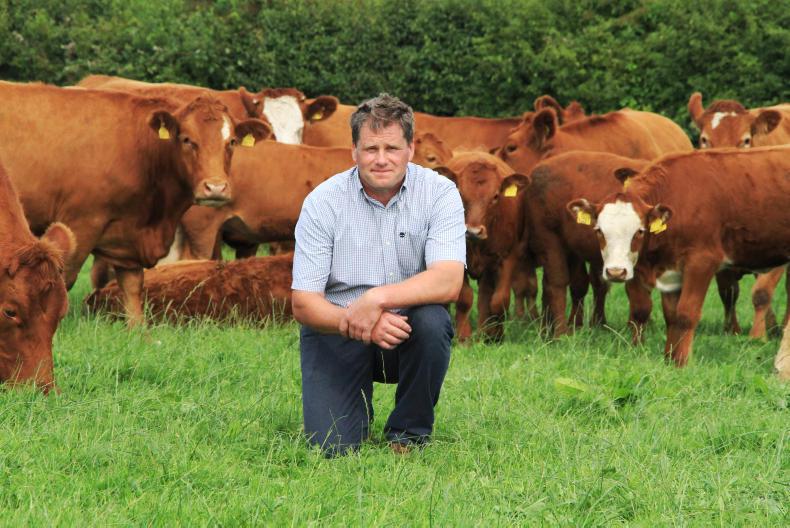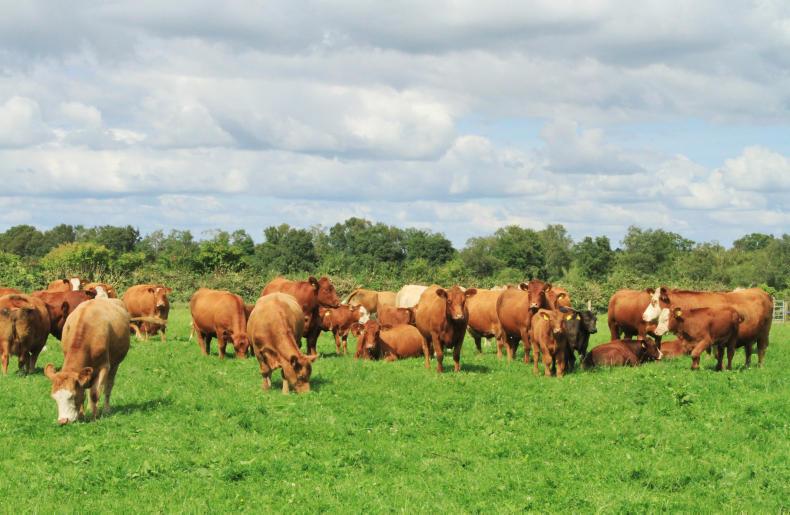Sean Hayden farms 30 purebred Stabiliser cows and 57 commercial cross cows running on 49.31ha in Urlingford, Co Tipperary.
Hayden invested in his first Stabiliser bull in late 2013 after going to a visit a Stabiliser breeder in Co Antrim.
Hayden’s plan in the future is to upgrade to a herd of 100% purebred Stabilisers.
His herd was originally made up of Continental cross cows that were struggling to make money.
Listen to “Sean Hayden chat to Daniel McPartlin about his Stabiliser cattle” on Spreaker.
What are Stabiliser cattle?
Stabilisers are a four-way cross of Simmental, Angus, Hereford and Gelbvieh, a German breed.
They are designed to maximise the production benefits that result from crossbreeding.
The average Stabiliser cow is 650kg and is bred for:
Improved cow fertility.Calf survival and calf growth.Reduced cow maintenance.Reduced calving difficulties.Cow longevity.The ability to calve at 24 months of age. Calving
Sean said: “The calving difficulty was very high and some of the cows were mad”.
Now, it’s “almost like running a drystock farm,” he said.

The cows calve themselves 99% of the time and the calves are small and hardy weighing only between 30kg and 35kg.
Looking at Sean’s 2016 figures his mortality at birth was a mere 1.3% with 100% of his heifers calved before 24 months of age.
Average cow weight
Hayden has nearly taken 100kg off his average cow weight since 2013, which enables farmers like Sean to keep up to 15% more cows per hectare.
The Stabilisers progeny have great food conversion efficiency and have a better growth rate, resulting in animals finishing faster which in turn reduces winter feed costs.
His 2016 bulls sent to slaughter ranged between 12 and 15 months of age and graded from U+ to R- averaging 341kg carcase weight.
According to Dr Duncan Pullar from the Stabiliser Cattle Company: “Cow longevity, improved cow fertility, labour costs, lower feed and the ability of the Stabiliser heifer to calve before 24 months, translate into a saving that could be worth up to £383 (€420) per cow, or £38,300 (€42,014) for a 100-cow herd.”
Establishing the breed
In 1997, the beef improvement group or “BIG” was formed in east Yorkshire.
The main person driving forward breed improvement in Stabilisers is BIG technical director Richard Fuller.
The group was made up of four producers along with Fuller breeding 2,400 beef cows and they focused mainly on performance and progeny testing.
Several different continental breeds were tried and tested before eventually visiting Lee Leachman’s Cattle Company in Montana.
According to Fuller, “hybrid vigour is critical in maximising output from beef herds”.
The Stabiliser breed was selected to develop in the UK as a new and improved dual-purpose beef cow.
Now, 20 years later, there are 10,000 cows across 110 herds in the UK and the breed is the fastest growing breed in the UK, Fuller said.
The Stabiliser breed is recognised since 2014 as a pedigree breed under EU regulations.
Sean Hayden farms 30 purebred Stabiliser cows and 57 commercial cross cows running on 49.31ha in Urlingford, Co Tipperary.
Hayden invested in his first Stabiliser bull in late 2013 after going to a visit a Stabiliser breeder in Co Antrim.
Hayden’s plan in the future is to upgrade to a herd of 100% purebred Stabilisers.
His herd was originally made up of Continental cross cows that were struggling to make money.
Listen to “Sean Hayden chat to Daniel McPartlin about his Stabiliser cattle” on Spreaker.
What are Stabiliser cattle?
Stabilisers are a four-way cross of Simmental, Angus, Hereford and Gelbvieh, a German breed.
They are designed to maximise the production benefits that result from crossbreeding.
The average Stabiliser cow is 650kg and is bred for:
Improved cow fertility.Calf survival and calf growth.Reduced cow maintenance.Reduced calving difficulties.Cow longevity.The ability to calve at 24 months of age. Calving
Sean said: “The calving difficulty was very high and some of the cows were mad”.
Now, it’s “almost like running a drystock farm,” he said.

The cows calve themselves 99% of the time and the calves are small and hardy weighing only between 30kg and 35kg.
Looking at Sean’s 2016 figures his mortality at birth was a mere 1.3% with 100% of his heifers calved before 24 months of age.
Average cow weight
Hayden has nearly taken 100kg off his average cow weight since 2013, which enables farmers like Sean to keep up to 15% more cows per hectare.
The Stabilisers progeny have great food conversion efficiency and have a better growth rate, resulting in animals finishing faster which in turn reduces winter feed costs.
His 2016 bulls sent to slaughter ranged between 12 and 15 months of age and graded from U+ to R- averaging 341kg carcase weight.
According to Dr Duncan Pullar from the Stabiliser Cattle Company: “Cow longevity, improved cow fertility, labour costs, lower feed and the ability of the Stabiliser heifer to calve before 24 months, translate into a saving that could be worth up to £383 (€420) per cow, or £38,300 (€42,014) for a 100-cow herd.”
Establishing the breed
In 1997, the beef improvement group or “BIG” was formed in east Yorkshire.
The main person driving forward breed improvement in Stabilisers is BIG technical director Richard Fuller.
The group was made up of four producers along with Fuller breeding 2,400 beef cows and they focused mainly on performance and progeny testing.
Several different continental breeds were tried and tested before eventually visiting Lee Leachman’s Cattle Company in Montana.
According to Fuller, “hybrid vigour is critical in maximising output from beef herds”.
The Stabiliser breed was selected to develop in the UK as a new and improved dual-purpose beef cow.
Now, 20 years later, there are 10,000 cows across 110 herds in the UK and the breed is the fastest growing breed in the UK, Fuller said.
The Stabiliser breed is recognised since 2014 as a pedigree breed under EU regulations.







 This is a subscriber-only article
This is a subscriber-only article







SHARING OPTIONS: